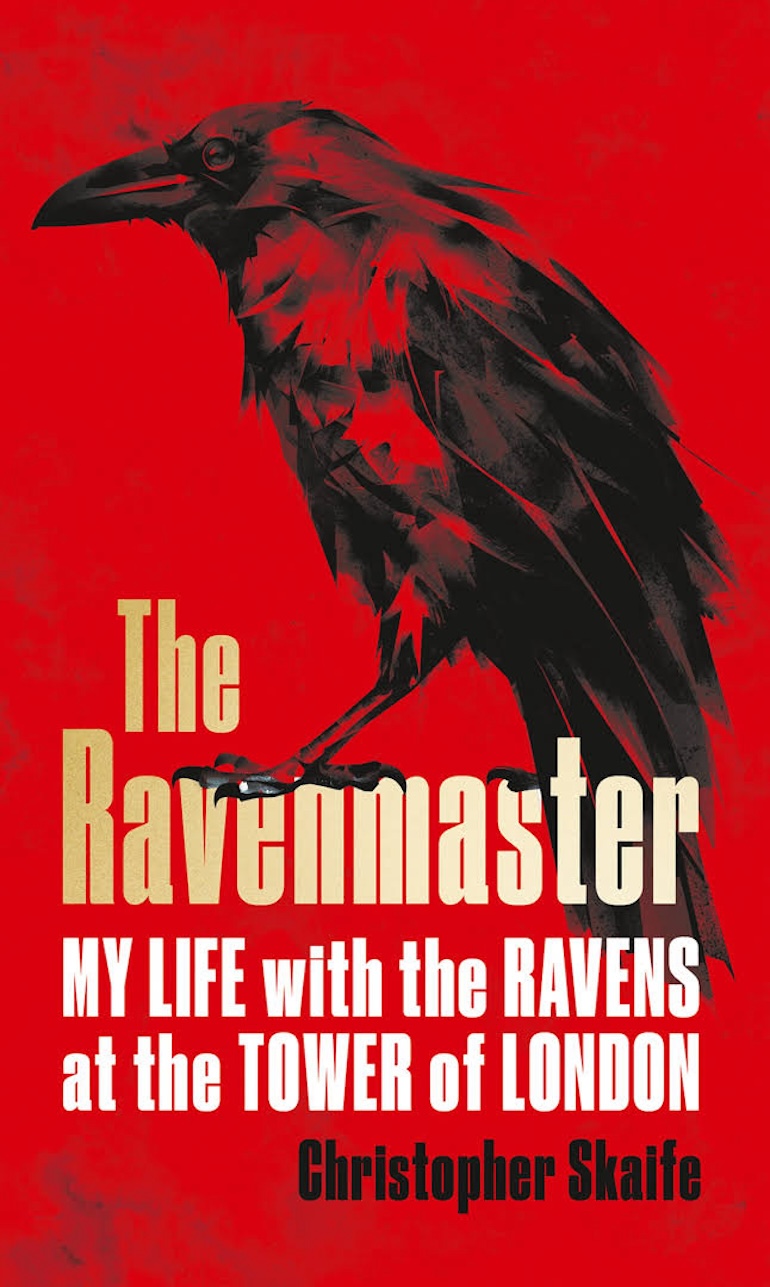According to legend, King Charles II, who ruled Great Britain for twenty-five years after the restoration of the monarchy in 1660, was told, when the royal astronomer Sir John Flamsteed complained about the ravens, that the safety of the kingdom was threatened if the birds ever left the Tower of London. King Charles II then decreed that there should always be at least six ravens there to prevent the Tower – and the kingdom – from falling down. History does not record what Flamsteed thought of this decision, but he had to accept it.
The Ravenmaster
 The ravens have been at the Tower of London ever since, and for the last fifty years or so, they have had a keeper who is known as The Ravenmaster. The previous Ravenmaster Chris Skaife, who retired from the role in early 2024, wrote a book called The Ravenmaster: My Life with the Ravens at the Tower of London, which explained his work and many of the legends of these birds, who now have dedicated cages built by Skaife in the area beneath and to the south of the White Tower, the oldest part of the Tower of London. Skaife will continue living there while serving as a Yeoman Warder.
The ravens have been at the Tower of London ever since, and for the last fifty years or so, they have had a keeper who is known as The Ravenmaster. The previous Ravenmaster Chris Skaife, who retired from the role in early 2024, wrote a book called The Ravenmaster: My Life with the Ravens at the Tower of London, which explained his work and many of the legends of these birds, who now have dedicated cages built by Skaife in the area beneath and to the south of the White Tower, the oldest part of the Tower of London. Skaife will continue living there while serving as a Yeoman Warder.
Chris Skaife was the Yeoman Warder who really put the job of Ravenmaster on the map. Not only did he write a book about his work, but he became a master of social media and built up a considerable following on Facebook. Chris built cages for the birds to live in and was always aware of where they were at any time. In 2017, he took a group of Blue Badge Tourist Guides around the Tower and told them about his work as Ravenmaster. He also gave a talk to guides before a Members’ Meeting. He emphasised that their wings are ‘trimmed’ and not clipped, which discourages them from trying to fly away from the Tower. Ravens are naturally mountainous birds and have had to adapt to life in an urban environment. They can also be very vicious, and Chris says that a raven’s beak is strong enough to bite off a human finger.
Yeoman Warder
Chris serves as a Yeoman Warder at the Tower of London. These men – and now five women – are often referred to by their nickname of Beefeater. No one is absolutely sure where this name, which is entirely unofficial, comes from, but it probably originates from what was assumed to be their rich, meaty diet, which they enjoyed by being in close proximity to the monarch. (It may also be a corruption of the French word ‘buffetier’.) There are thirty-two Beefeaters at the Tower plus one Chief Warder, each being a former member of the British armed forces who has reached the rank of sergeant and served without blemish for twenty-two years. The order was founded by King Henry VII in 1485 when he succeeded to the throne and felt that he needed a force of experienced soldiers who would act as his bodyguard. They are based at the Tower of London, and their duties include conducting tours of it for casual visitors.
Skaife has now been succeeded as Ravenmaster by Michael ‘Barney’ Chandler, who has been at the Tower of London for fifteen years since his appointment in 2009 as the Tower’s 387th Yeoman Warder. A former marine, he has served in Helmand Province in Afghanistan and other centres where he has been deployed. Although ravens have been at the Tower of London for over 300 years, Barney is only the sixth Beefeater to have held the post officially. It was created by the first Ravenmaster, Jack Wilmington who came to the Tower of London in 1968. The Ravenmaster wears a conventional Yeoman Warder uniform but with the addition of a badge which features an image of a raven worn on the sleeve of their uniform.
 New Tower of London Ravenmaster Barney Chandler. Photo Credit: © Historic Royal Palaces.
New Tower of London Ravenmaster Barney Chandler. Photo Credit: © Historic Royal Palaces.
The Ravenmaster leads a team of four Beefeaters who share the duties of caring for the birds. These include maintaining their enclosures and keeping them fed and watered on a diet of raw meat – with the occasional egg and blood-soaked biscuit as a treat. The team are also responsible for the health and wellbeing of the ravens, ensuring they are comfortable in their home where they can be seen by the Tower’s three million visitors every year. At the time of writing, there are seven ravens at the Tower of London, each with its own name. They are called Jubilee, Harris, Poppy, Georgie, Edgar, Branwen and the most recent Rex. The name means ‘king,’ and he was named for Charles the Third following his coronation in May 2023.
Visitors to the Tower are often accompanied by a Blue Badge Tourist Guide who will relate to them stories of the famous prisoners held there before taking them to see the Crown Jewels. These are used in the ceremony of the coronation which is held downriver at Westminster Abbey. The jewels include the Star of Africa diamonds which are the two largest cut diamonds in the world. The first and larger one weighs 530 carats and can be seen on the royal sceptre in the Jewel House. The second Star of Africa weighs 317 carats and is part of the Imperial State Crown which is worn at the coronation ceremony. Security is tight in the Jewel House, and photography is not allowed there. The queues can be very long to see Crown Jewels but virtually all visitors want to see them when visiting the Tower.
Prisoners held at the Tower of London included Elizabeth I before she succeeded to the throne as queen, and who was held there for three months by her half-sister Mary. Other prisoners include men like Thomas More, Thomas Cromwell and Walter Raleigh who spent over ten years in the Bloody Tower where he conducted scientific experiments, cultivated his garden and smoked the leaves of the new plant tobacco which he had introduced to Britain.
The Tower of London was also a place of execution, and amongst its victims were two wives of King Henry VIII: Anne Boleyn (Elizabeth’s mother) and Catherine Howard, who was Anne’s cousin. She was only nineteen when she was executed on Henry’s orders in February 1542.
Stories of the executed and imprisoned make the Tower of London come to life but visitors also enjoy finding out about the ravens who have lived there for many centuries and have now become established as part of the history of this iconic London building.
] View of the Tower of London and Tower Bridge from Horizon 22 in London. Photo Credit: © Ursula Petula Barzey.
View of the Tower of London and Tower Bridge from Horizon 22 in London. Photo Credit: © Ursula Petula Barzey.







Leave a Reply